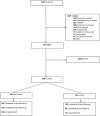Inpatient Addiction Consultation for Hospitalized Patients Increases Post-Discharge Abstinence and Reduces Addiction Severity
- PMID: 28526932
- PMCID: PMC5515798
- DOI: 10.1007/s11606-017-4077-z
Inpatient Addiction Consultation for Hospitalized Patients Increases Post-Discharge Abstinence and Reduces Addiction Severity
Abstract
Background: Alcohol and drug use results in substantial morbidity, mortality, and cost. Individuals with alcohol and drug use disorders are overrepresented in general medical settings. Hospital-based interventions offer an opportunity to engage with a vulnerable population that may not otherwise seek treatment.
Objective: To determine whether inpatient addiction consultation improves substance use outcomes 1 month after discharge.
Design: Prospective quasi-experimental evaluation comparing 30-day post-discharge outcomes between participants who were and were not seen by an addiction consult team during hospitalization at an urban academic hospital.
Participants: Three hundred ninety-nine hospitalized adults who screened as high risk for having an alcohol or drug use disorder or who were clinically identified by the primary nurse as having a substance use disorder.
Intervention: Addiction consultation from a multidisciplinary specialty team offering pharmacotherapy initiation, motivational counseling, treatment planning, and direct linkage to ongoing addiction treatment.
Main measures: Addiction Severity Index (ASI) composite score for alcohol and drug use and self-reported abstinence at 30 days post-discharge. Secondary outcomes included 90-day substance use measures and self-reported hospital and ED utilization.
Key results: Among 265 participants with 30-day follow-up, a greater reduction in the ASI composite score for drug or alcohol use was seen in the intervention group than in the control group (mean ASI-alcohol decreased by 0.24 vs. 0.08, p < 0.001; mean ASI-drug decreased by 0.05 vs. 0.02, p = 0.003.) There was also a greater increase in the number of days of abstinence in the intervention group versus the control group (+12.7 days vs. +5.6, p < 0.001). The differences in ASI-alcohol, ASI-drug, and days abstinent all remained statistically significant after controlling for age, gender, employment status, smoking status, and baseline addiction severity (p = 0.018, 0.018, and 0.02, respectively). In a sensitivity analysis, assuming that patients who were lost to follow-up had no change from baseline severity, the differences remained statistically significant.
Conclusions: In a non-randomized cohort of medical inpatients, addiction consultation reduced addiction severity for alcohol and drug use and increased the number of days of abstinence in the first month after hospital discharge.
Keywords: addiction; addiction consultation; hospitalized patients; post-discharge abstinence; substance use disorder.
Conflict of interest statement
The authors declare that they do not have a conflict of interest.
References
-
- Substance Abuse and Mental Health Services Administration. Results from the 2014 National survey on drug use and health: SAMHSA, 2014. Available at: http://www.samhsa.gov/data/sites/default/files/NSDUH-FRR1-2014/NSDUH-FRR... Accessed April 24, 2017.
-
- Centers for Disease Control and Prevention (CDC) CDC grand rounds: prescription drug overdoses—a U.S. epidemic. MMWR Morb Mortal Wkly Rep. 2012;61(1):10–13. - PubMed
-
- Rudd RA, Aleshire N, Zibbell JE, Gladden M. Increases in drug and opioid overdose deaths — United States, 2000–2014. MMWR. 2016;64(50):1378–82. - PubMed
MeSH terms
LinkOut - more resources
Full Text Sources
Other Literature Sources
Medical
Molecular Biology Databases


